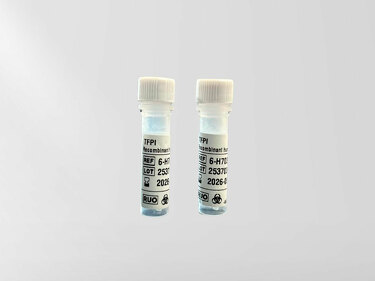Recombinant tissue Factor pathway inhibitor (TFPI) – Lyophilized solution


| 6-H7035-LYO-50 | Flacon | 50 µg |
Recombinant Tissue Factor Pathway Inhibitor (TFPI). The human TFPI protein, His-tagged (TFI-HS226), is produced from human HEK293 cells. It contains amino acids from Asp 29 to Lys 282. This protein has a polyhistidine (His) tag at the C-terminal end.
Description of the Recombinant tissue Factor pathway inhibitor (TFPI) – Lyophilized solution
Recombinant Tissue Factor Pathway Inhibitor (TFPI). The human TFPI protein, His-tagged (TFI-HS226), is produced from human HEK293 cells. It contains amino acids from Asp 29 to Lys 282. This protein has a polyhistidine (His) tag at the C-terminal end. This active form of TFPI is ideal for functional studies, enzyme assays, or translational research applications in hemostasis and thrombosis.
Appearance: Lyophilized solution of 50 µg.
Concentration: Variable depending on the batch.
Purity: > 90% (determined by SDS-PAGE).
Calculated Molecular Weight: 30.0 kDa.
Storage Temperature: -20°C to -70°C for 12 months in lyophilized form from the date of receipt; -70°C for 3 months under sterile conditions after reconstitution. Once reconstituted, store the stock solution at -70°C immediately and avoid repeated freeze-thaw cycles.
Recommendations: Add a stabilizing protein (e.g., HSA or BSA at 0.1%) for prolonged storage or when aliquoting.
Informations
Physiologically, the Tissue Factor (TF) pathway is inhibited by a specific inhibitor, TFPI, but also by antithrombin. TFPI is the most potent inhibitor. It is constitutively synthesized by endothelial cells and megakaryocytes. It can also be synthesized by monocytes-macrophages and trophoblastic cells.
In plasma, TFPI circulates bound to lipoproteins. It belongs to the Kunitz-type inhibitor family. There are three storage sites for TFPI: platelets, plasma (where 90% of TFPI is bound to various lipoproteins), and finally the surface of endothelial cells, where it is bound to glycosaminoglycans.
TFPI inhibits the TF pathway by forming a quaternary complex with TF/FVIIa/FXa. TFPI first binds to the active site of FXa to form a binary complex in which FXa is neutralized. Then, in the presence of calcium, TFPI secondarily binds to TF/VIIa. The quaternary complex thus formed is internalized through a mechanism involving clathrin-coated pits and the low-density lipoprotein scavenger receptor.
Therefore, the inhibition of the TF pathway by TFPI requires the prior generation of FXa. Inhibition of the TF/VIIa complex requires that a sufficient amount of TFPI/Xa complexes be formed.
B. Jude, S. Susen "Disseminated Intravascular Coagulation in Intensive Care: Use of Inhibitors of the Tissue Factor Pathway", Réanimation, 2002 december















